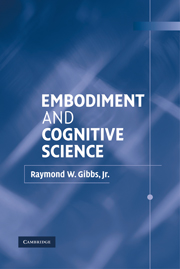2 - Bodies and Persons
Published online by Cambridge University Press: 05 June 2012
Summary
Each of us feels some intimate connection between who we are and our bodies. When someone punches my nose, I, Raymond W. Gibbs, Jr., and not someone else, experience pain. When I wonder if I feel happy, I consider this in terms of my own embodied being, and not someone else's. When I experience the pleasures of sex, the discomfort of feeling cold, or the fatigue from running five miles, I clearly know that my body is the sole source of these sensations.
Yet when I think about the existence of God, or try to solve a complex math problem, I have little awareness that my body has a place in my thoughts. Cognitive processes seemingly occur with little input from our bodies. The very act of perception focuses on perceptual objects/events out in the world in such a way that the body recedes into the background and feels almost unnecessary (Leder, 1990). This “corporeal disappearance” allows us, for better or worse, to objectify the body. We see the body as a material object, whereas the self and the mind are ethereal entities that somehow mysteriously invade or permeate the body. The traditional maxim of “mind over matter” captures the common belief that the immaterial mind rules supreme over the corporeal body.
What is the relationship between persons and their bodies? One may argue that oneself, one's person, is a pure thinking being, similar to that envisaged by Descartes.
- Type
- Chapter
- Information
- Embodiment and Cognitive Science , pp. 14 - 41Publisher: Cambridge University PressPrint publication year: 2005



